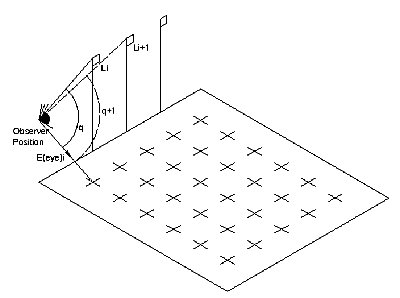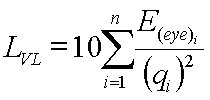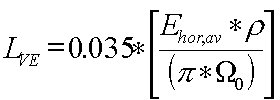
![]()
Calculations Glare Rating Concepts
In 1994, the CIE developed a glare evaluation method for outdoor sports lighting and area lighting applications (CIE document 112-1994). This system is available for checking the Glare Rating situation of existing installations and for predicting glare rating at the design stage in new installations.
|
|
The Glare Rating calculation grid provides an indication of glare experienced by the observer for each point in the grid based on the veiling illuminance produced by the luminaires and the environment (ground plane only) on an observer's eye. It is measured as the observer looks at each point on a horizontal illuminance grid. Glare Rating is restricted to horizontal grids of points below eye level and is used in outdoor area and sports lighting applications. A lower Glare Rating value (GR) indicates better glare restriction. |
Each glare rating grid is tied to one observer position. Glare rating is calculated for each point on grid based on the veiling luminance produced on the eye by the luminaires and the environment.
When Glare Rating is specified, grids are created for each observer position that duplicate the specified horizontal illuminance grid. Each GR grid is identified by its correlated observer position, which are labeled sequentially, Obs_1, Obs_2, etc. In Project Manager, each GR grid is identified by its observer position and calculation points label.
For example, a horizontal grid labeled “football” with one observer position would have a Glare Rating grid associated with it called “football-Obs_1.” In Project Manager, there would be two related grids associated with football: the horizontal illuminance grid “football” and “football-Obs_1.”
The Glare Rating calculation does not take reflective or obstructive entities around or within the GR grid into account.
Glare Rating Equations

Veiling Luminance Equations considering luminaires and environment
|
Lvl = Veiling luminance on the eye produced by the luminaires for one point. i = the current luminaire being considered. n = total number of luminaires in the job file. E(eye), i = the illuminance produced on the observer's eye in a plane perpendicular to the line of sight, produced by the ith source, in lux. qi = the angle between the observer's line of sight and the direction of light. |
|
|
|
LvE = Veiling luminance on the observer's eye produced by the environment. Ehor,av = Average horizontal area illuminance (ground plane). r = the reflectance of the area assuming diffuse reflection. W0 = the unity solid angle in steradians. |
Nine Point Glare Assessment Scale
When glare rating was first experimented with by CIE researchers, a glare control mark GF was used that relates to the Glare Assessment scale shown below. As the GF marker increases in value, the better glare restriction that is provided by the installation. The glare assessment scale provides meaningful visual information regarding the differences in glare rating values.
Glare rating GR is related to GF by this equation:
![]()
|
Glare Control Mark GF |
|
Glare Rating GR |
|---|---|---|
|
1 |
Unbearable |
90 |
|
2 |
|
80 |
|
3 |
Disturbing |
70 |
|
4 |
|
60 |
|
5 |
Just Admissible |
50 |
|
6 |
|
40 |
|
7 |
Noticeable |
30 |
|
8 |
|
20 |
|
9 |
Unnoticeable |
10 |
A variation of +/- 0.5 in Glare Rating is equivalent to an experimental accuracy ratio of +/- 5% in the Luminance ratio.
Recommended Glare Rating Limits
To ensure that glare is not excessive in any normal viewing direction at any normally accessible point on the illuminated area, the maximum value of GR should always be less than the recommended value of GRmax.
Area Lighting Applications
|
Type of Application |
|
GR Max |
|---|---|---|
|
Safety & Security |
Low Risk |
55 |
|
|
Medium Risk |
50 |
|
|
High Risk |
45 |
|
Movement & Safety |
Pedestrians Only |
55 |
|
|
Slow Moving Traffic |
50 |
|
|
Normal Traffic |
45 |
|
Work* |
Very Rough |
55 |
|
|
Rough-Medium |
50 |
|
|
Fine |
45 |
(*) In a work area where viewing tasks are of decisive importance, it is advisable to have a maximum glare rating value five units lower than the specified GRmax.
Sports Lighting Applications
| Type of Application | GR Max |
|---|---|
| Lighting for Training Purposes | 55 |
| Lighting for Competition Purposes | 50 |


